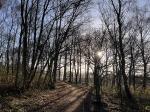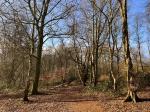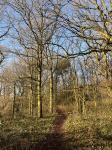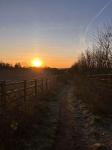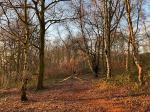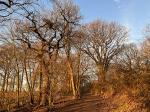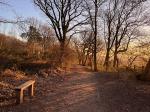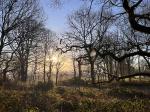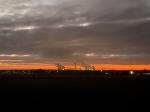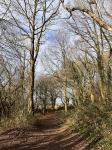Brayton Barff Through the Seasons.
Set in the Vale of York, South West of the market town of Selby and between the villages of Thorpe Willoughby and Brayton, lies Brayton Barff, a sandstone Hill approximately one hundred and fifty feet in height which was formed by glacial movement during the last Ice Age. It is a significant landmark in an otherwise flat landscape.
Today the site is primarily owned by Yorkshire Water with Selby District Council owning a small patch of the land adjacent to the A63 Selby bypass. A large underground reservoir occupies the centre of the site which delivers water to around 4.7 million customers throughout Yorkshire.
Within the Barff woodland over 40% of the trees are Sessile Oak which are generally found in semi natural woodlands in the north of the country. These trees are so called because its acorns are not held on stalks, like those of the English Oak (Pedunculate), but attached directly to the outer twigs. There are also several English Oak trees as well as some cross-hybrid oaks. These trees are known to support many species of flora and fauna, invertebrates, mosses, lichen and fungi.
During the Victorian times it is thought that the shipbuilders on the east coast would come over to the Barff for selected cuts of timber to build their sea going vessels.
The Barff also has a variety of other trees including Silver Birch, Beech, Sycamore, Holly, Rowan, Scots Pine, Alder, Hawthorne and European Larch. There are also several Yew, Willow, Hazel, Horse Chestnut and Wych Elm. As with similar woodlands there are a variety of bushes, including Honeysuckle, Elderberry, Gorse, Broom and Buddleia.
The history of Brayton Barff is quite vague, apparently during 1803 a beacon was lit on the Barff when the country was threatened with an invasion by Napoleon. In May 1935, to celebrate King George V's Silver Jubilee, a Bonfire was lit on the Barff as part of the celebrations.
Early issues of Ordnance Survey Maps dated 1903 clearly show a rifle range on the Barff, extending out to Mill Lane. During the 
Between 2001 – 2004 the A63 Selby bypass, 10km twin lane single carriageway was constructed which severed the South West corner of the Barff, adjacent to Selby Golf Course and resulted in a slight redesign of several holes on the golf course. Wooden fencing was erected as a result of this new road running alongside of the Barff and a footbridge constructed over the ‘new road’ following the line of the Bridal way which extends from Mill Lane. Around 2005/2006 a definite 2metre wide limestone aggregate footpath was laid forming a circular path around the outer edges of the woodland. This footpath is approximately 1.2 miles in length and takes about 30 minutes to circumnavigate at a leisurely pace.
In 2012 the Barff was declared an Ancient Oak Woodland and as such throughout 2012 and 2013 significant work had been carried out by the relevant agencies to cut and remove large swathes of non-native trees, creating at that time huge scars on the landscape. Some three years later the planting of the native trees have become well established and are flourishing. Ongoing maintenance work on the footpath around the bottom of the Barff was completed during the Summer of 2016.
A second phase of woodland maintenance commenced during the Autumn of 2019 with the removal of many old and diseased trees and the cutting back of the Gorse and Broom bushes, especially adjacent to the ‘bypass trail’, this work continued through till March 2020 with re planting continuing into April 2020.
Brayton Barff is a popular site for walkers and bird watchers alike and a path circling the outer perimeter of the Barff makes a pleasant thirty minute walk, giving views looking over towards Selby and the village of Brayton as well as the power stations of Drax and Eggborough..jpg)
For the early risers it is a great place to see some stunning sunrises over the villages of Brayton looking towards Drax Power Station, the same with the Sunsets looking over towards Eggborough and Monk Fryston.
The Barff changes with the Seasons and every visit can reveal something new, the woodland is a haven for wildlife. Records show that since 1982 one hundred and twelve species of bird have been seen in the woodland and at least 40 of those have bred here, including Tawny Owl, Buzzard, Green Woodpecker, Spotted Flycatcher, Goldcrest and Nuthatch to name just a few. On average over 70 species of bird are recorded each year. Further details of the bird life on the Barff can be found on the Brayton Barff Group Facebook page, especially the posts from Derek Cooper. Today ‘The Friends of Brayton Barff group’ led by Derek and a small team of volunteers help keep and maintain the cleanliness of the site as well as recording the wildlife and bird sightings.
The Barff is also home to fifteen different species of mammals, including Muntjac Deer, Pipistrelle Bat, Fox, and Field Vole.
Over eighty species of plant and wildflowers have been recorded, included Bee Orchid, Northern Marsh Orchid, Wood Anemone, Marsh Ragwort, Bluebell, White Bluebell, Bittersweet and Purple and White Foxgloves. Over twenty species of Butterfly have been recorded, including Marbled White, Brown Angus, Speckled Wood, Comma and Brimstone.
During the Autumnal months fungi thrives in this woodland environment, species including Fly Agaric, Beefsteak Tree Fungi, Chicken of the Wood, Sulphur Tufts, Stinkhorn, Ink cap, Puffballs and Hoof Bracket are just some of the many varieties that can be found here.
Click on the galleries shown below to expand the albums.
February 2023
Well, here we are at the end of February with Spring just around the corner.
Fortunately, winter seems to have missed this part of the county to date. For most of February it has been relatively dry, with temperatures ranging between -2C to 10C, most of the tracks and trails around the Barff have remained dry and what little rain we have had has fallen during the hours of darkness. As I write this, I have just read a note from the Met office which has published its provisional figures for February, which states that this month has been the driest for 30 years and that the UK as a whole saw less than half the average rainfall for February with just 1.7in falling.
We have had some beautiful sunrises, some foggy and misty mornings and some dull and cloudy mornings too. No snow yet. It is nice to see the mornings getting lighter and brighter.
No two mornings on the Barff are the same, it can be dull cloudy and overcast one day, the following morning it can be bright and sunny, some mornings the bird song is amazing whereas another morning it can be quiet. The light has been quite varied too, mostly dull and cloudy, then on another day just before the sun rises, we catch what I call ‘the golden hour’ where a warm golden hue fills the air, then, after a cold overnight frost there is a tinge of blue in the air.
Signs of Spring are beginning to appear all around the woodland, Hazel Catkins are in excess of three inches in length and still growing, nettles are sprouting up amongst the brambles, various species of fungi continue to appear sometimes on a daily basis. Elderberry bushes are coming into leaf, one or two patches of Snowdrops have appeared and are still in full flower. Gorse bushes are still in flower, their tiny yellow florets adding a touch of colour to the Barff, and the Hawthorn bushes are beginning to come into flower with tiny little white florets appearing. Clumps of daffodils are beginning to flower especially those positioned in full sun and small clumps of Crocus are currently enjoying this milder weather. The green shoots of Bluebells have really shot up with the Barff greening up on a daily basis. What is interesting to note is that several of the Oak trees have yet to shed their leaves, although the leaves have died back and perished, they are still clinging on to the tree branches, no doubt after a few severe frosts and some high winds they will eventually fall.
Several highlights for me this month were the Skylarks hovering high up above the trees and scrub land singing their hearts out, The Song Thrush belting out a chorus of tunes along the bypass trail and finally, I had a dark 6.00am start one morning and heard at least three, possibly four Tawny owls, both male and female were calling to each other near to the old pumping station, I must have disturbed them with my headlamp. Other birds I have seen most days are Tree Creepers, Robins, Long Tailed Tits, Dunnocks and Blue and Great Tits. The Nuthatch, Great Tits and Greater Spotted Woodpeckers have certainly become much more vocal as the month draws to a close. Grey Squirrels continue to thrive amongst the trees in the woodland and can be seen and heard most days as they squabble and chase each other along the tree branches. On Sunday 12th I watched a young Fallow deer for a few moments, not very far from the perimeter footpath and relatively close to the car park, it soon disappeared into the heart of the woodland once it had picked up my scent.
I spent a very nice week down in Kent during the middle part of the month, though it is always nice returning to the Barff to see what has changed since before I went away and with Spring in the air the countryside is changing daily. Lets see what March has to bring.
|




